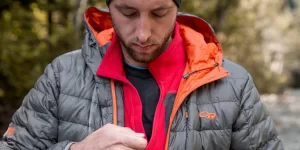
The idea of this post is to explain how the three-layer system (or onion-type clothing) currently used in mountain activities works. Surely those of the old school have different opinions and it is highly respectable, but the idea is not to make comparisons, but rather to see a general overview of current technologies and their benefits.
In El Chaltén as in any other hiking destination, we can start trekking with a good pair of sneakers (idealy ones with grip on the bottom), the typical school jogging suit, a polar sweatshirt and a warm jacket… Everyone knows their budget and we can always make do with what we have.
More than once we have seen photos, videos or perhaps a movie related to those legendary expeditions that took place in the late nineteenth and early twentieth centuries, and surely we have been surprised by the clothes they used, the tools and the amount of weight they had to carry.
And no wonder, it was not until the mid 80’s that synthetic fiber garments, polar linings and the first jackets with waterproof and breathable membranes appeared (until then, waterproof jackets were not breathable, so they were not recommended for outdoor activities).
Over the years, technologies have evolved and names that may be familiar to us today have appeared: GoreTex, PowerDry, Softshell, etc.

The 3-layer system (or onion system), besides being convenient and practical because we can put on or take off layers if necessary, is very useful for the following reasons:
In summary: In addition to protection, we need to have the body as dry as possible, both from the outside and inside moisture, and in turn we need a garment that keeps us warm avoiding the loss of body heat.
Let’s take a closer look at the functions of each layer:
This layer is well known as “thermal interiors” or “liners“, this layer is intended to be as close to the body as possible and there are shirts, pants, gloves and socks.
Its main function is to keep the body dry, absorbing all the sweat and expelling it to the second layer. And in conjunction with the top layer, it helps retain heat.
It is in charge of keeping us warm. We usually use polar or micro polar fleece overalls or jackets. Depending on how cold we are, we can use only one polar or combine it with another. For the legs we usually use trekking pants or tights and for the head a hat or buff.
This layer is also in charge of collecting the humidity sent by layer 1 and evacuating it to the outside, thus avoiding heat loss by conduction.
Important about down jackets: They are not recommended while walking because they get wet with sweat and lose their warmth (besides taking a long time to dry). They are perfect for use at the campsite.
The main function of this layer is to insulate us from factors such as rain and snow, and also prevents us from losing temperature by convection (it cuts the wind). It is also responsible for expelling all the sweat generated, so it is recommended that it be made with waterproof and breathable membranes.
Important: Precisely because of these GoreTex membranes, the third layers (jackets or pants) are usually quite expensive. Therefore, if you are just starting out, it is not advisable to spend a lot of money here (it is better to prioritize a good pair of sneakers or trekking boots).
We can use any windbreaker type jacket, but always bearing in mind that since it is not waterproof/breathable, we will have to open the zipper from time to time so that the sweat does not start to get wet inside.
As we have seen so far, the 3-layer system has many benefits if used correctly and using the right materials. But as we said at the beginning: Don’t rush out to spend money because it doesn’t make sense (in case you want to try, there are several places in town to rent). Prioritize first the shoes, a good backpack or a good sleeping bag.
TrekkingElChalten.com started as a project born from a group of friends passion for the mountains. Here you will learn about all the different activities you can partake in El Chaltén, the hiking capital of Argentina.
Designed by StreetSud – Servicios Digitales in Patagonia Argentina |
Copyright © 2024 | Trekking El Chalten